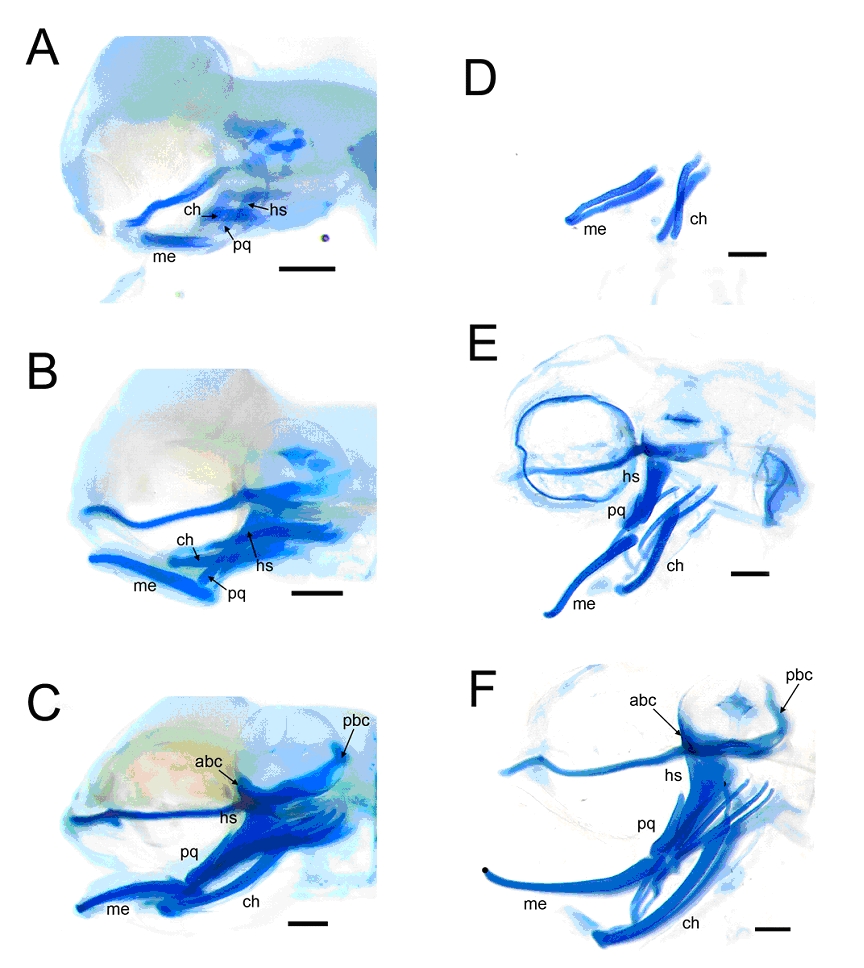Fig. S1
Developmental stages of P. antarcticum (A-C) and C. aceratus (D-F). (A, C) Prehatching stages, equivalent to stages ∼60 hpf and ∼52 hpf, respectively, of the zebrafish hatching period (19). (B, E) Early-larvae stages, equivalent to ∼74-90 hpf of the zebrafish larval period. Since C. aceratus specimens were systematically collected from a single clutch over the course of ∼40 day, staging was a bit more straightforward. The C. aceratus specimen in (E) is 8 days older than that depicted in (D); it also corresponds to approximately zebrafish stage ∼74 hpf. This is the protruding mouth stage in zebrafish and is characterized by the anterior extension of the jaw just past the eye. Based on these two time-points (i.e., D and E), we inferred that each day of development in notothenioids (at -1.5° C) corresponds to 2.5 hrs of development in zebrafish (at 28.5° C). (C, F) Mid-larvae stages, equivalent to zebrafish stage 5-6 dpf. The specimen in (F) is 24 days older that (E), and should therefore be at a similar stage as a 6 dpf zebrafish larvae. This is consistent with the presence of teeth in C. aceratus larvae at this stage. Staging of P. antarcticum was less straight forward, as samples represented natural populations of embryos collected beneath the sea ice (63). The sample in (A) was collected from Terra Nova Bay, Antarctica, on November 7, 2005, and was determined to be equivalent to zebrafish stage ∼60hpf. The sample in (B) was collected 20 days later, but there was clearly a range of developmental stages present in this collection. In particular, there were differences in the degree of mouth protrusion. This particular fish represented one of the younger samples, and based on the presence and absence of individual skeletal structures (Table S1), was determined to be at approximately the same stage as C. aceratusin panel (E). Fish collected on November 27 were subsequently reared for another 16 days in aquaria, and, based on the developmental “clock” applied to C. aceratus, these fish should be equivalent to zebrafish stage ∼5 dpf. As before, this collection contained a range of stages, and the specimen depicted in panel (C) was one of the older individuals equivalent to zebrafish stage ∼5.5 dpf.
Beyond specific developmental stages, it is important to note that the yolk sac was nearly absorbed in the oldest notothenioid specimens sampled, marking the onset of exogenous feeding. In both zebrafish and stickleback, and indeed most teleost species, the craniofacial skeleton is well mineralized by this developmental event to accommodate the functional demands of feeding. The observation that notothenioids lack this mineralization at hatching is significant and supports our conclusion that the osteogenic developmental program is delayed in these species. Abbreviations: abc, anterior basicranialcommissure; ch, ceratohyal; hs, hyosymplectic; me, Meckel’s cartilage; pbc, posterior basicranialcommissure; pq, palatoquadrate.Scale bars, 200 μm.
Image
Figure Caption
Acknowledgments
This image is the copyrighted work of the attributed author or publisher, and
ZFIN has permission only to display this image to its users.
Additional permissions should be obtained from the applicable author or publisher of the image.
Full text @ BMC Evol. Biol.

